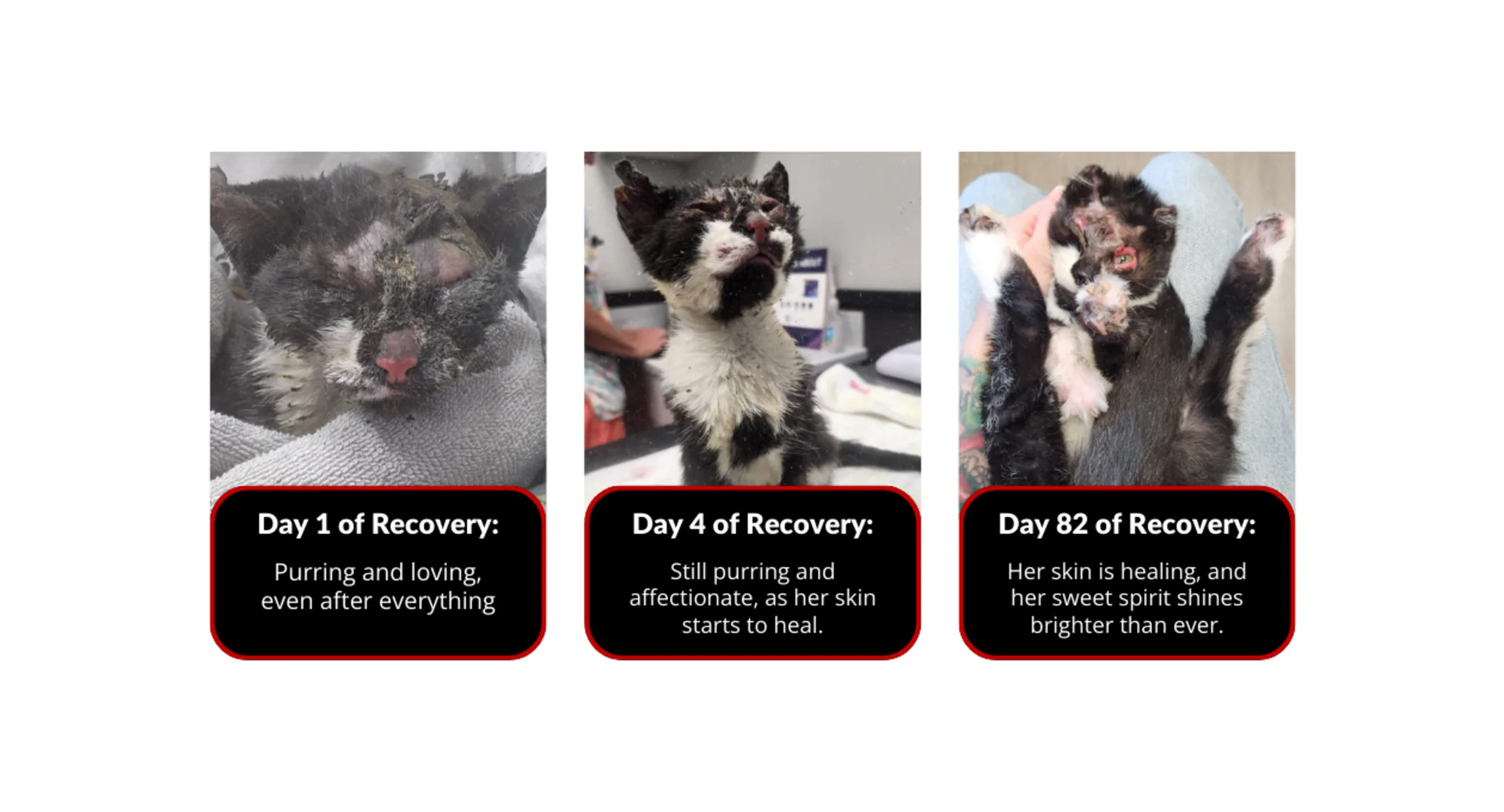Phoenix Rises: Brave Kitten Defies the Odds After House Fire, Healing Toward a Full Recovery
News

Recovery Smoke Inhalation in Companion Animals
House fires are devastating, destroying belongings, memories, and financial assets in an instant. In these moments, we often consider ourselves fortunate if no one is harmed. However, it’s not always possible to save every family member, including our pets. Out of fear, they may hide in dangerous places, making rescue difficult. But what happens if your pet survives a fire? Is euthanasia the only option?
Meet Phoenix, a 4-month-old kitten who beat incredible odds after surviving a house fire. Thankfully, the local rescue group Wild Whiskers stepped in to help. They brought Phoenix to our 24-hour emergency facility, where Dr. Brink, our Medical Director, took charge of her care. Dr. Brink described Phoenix as one of the most severe burn cases she had ever seen. Despite her injuries, this resilient kitten showed an incredible will to live, and our team committed to doing everything we could to help her.
Emergency Care for Burn Patients
The first priority in fire-related injuries is addressing respiratory distress oxygenation. Smoke inhalation and heat can cause severe damage to the airways and lungs. Toxins found in the smoke, such as carbon monoxide, can cause severe illness and even death. Oxygen therapy helps to remove these toxins and can be delivered through various methods, including:
Flow-by oxygen (via mask)
Nasal cannulas (like those used for humans)
Snyder oxygen cages (specialized kennels providing consistent oxygen)
Oxygen chambers
High-flow oxygen therapy
Mechanical ventilation
Phoenix was placed in an oxygen chamber upon arrival to the hospital
Another critical step is managing hydration and fluid therapy. While fluid resuscitation is essential, it must be carefully monitored to avoid exacerbating swelling or edema. Swelling from burns can take up to 12 hours to fully develop, requiring round-the-clock monitoring. Airway obstruction is a major concern, and if swelling blocks the trachea, intubation and ventilator support may be necessary to ensure the patient can breathe.
Additionally, delayed lung injuries like pulmonary edema (fluid buildup in the lungs) can develop 24–48 hours post-fire. While initial X-rays may appear normal, a CT scan can detect lung damage sooner, allowing for earlier intervention.
Toxicity Concerns
Smoke inhalation also carries the risk of carbon monoxide (CO) and cyanide toxicity, which can cause serious neurologic symptoms. These effects may appear immediately or take up to six days to manifest. Signs to watch for include:
Carbon monoxide toxicity: Central nervous system (CNS) depression, muscle weakness, hearing loss, and lethargy.
Cyanide toxicity: Bright red gums, ataxia (unsteady gait), seizures, and initial hyperactivity.
Thankfully, Phoenix did not exhibit any symptoms of toxicity.
Pain Management and Wound Care
Pain control is paramount, especially for burn patients. Phoenix was started on intravenous methadone to manage her pain, and oral medications were added later. Injectable antibiotics were administered to prevent infections.
Burns around Phoenix’s face and eyes presented additional challenges. Her fur was singed, making it hard to assess long-term damage. To protect her eyes, we applied artificial tears and antibacterial ophthalmic ointments.
Bathing is typically avoided immediately after burns, but it’s important to clean soot from the fur to prevent further complications if ingested. For Phoenix, we used a warm, damp washcloth to gently clean her coat while minimizing stress on her healing skin.
Recovery and Resilience
Within 24 hours of care, Phoenix was purring and eating again! After stabilizing her condition, we discussed home care with her foster, who courageously took on the responsibility of her continued recovery. Phoenix would need ongoing wound management, as some of her skin would slough off during the healing process, requiring regular vet visits.
Our friends at Paw Paw Veterinary Clinic took over Phoenix’s care, guiding her through her recovery. Now 8 months old, Phoenix is thriving in her foster home. Although her eyelids are still healing, her doctors are optimistic about her progress. Her skin and fur have largely returned to normal, and she enjoys playing and snuggling like any other kitten. While her growth appears slightly stunted, she is well on her way to a full recovery.
Throughout this journey, Phoenix has captured the hearts of our community, thanks to her foster mom, who has shared her story. We are grateful to have played a role in Phoenix’s incredible journey and wish her a bright and healthy future!
